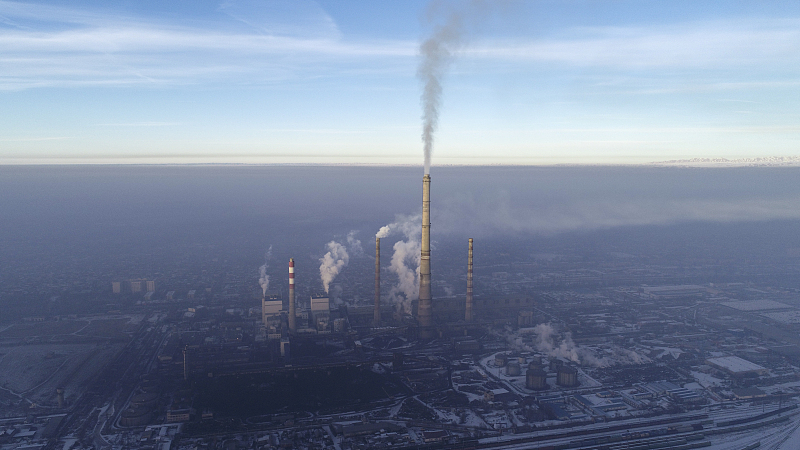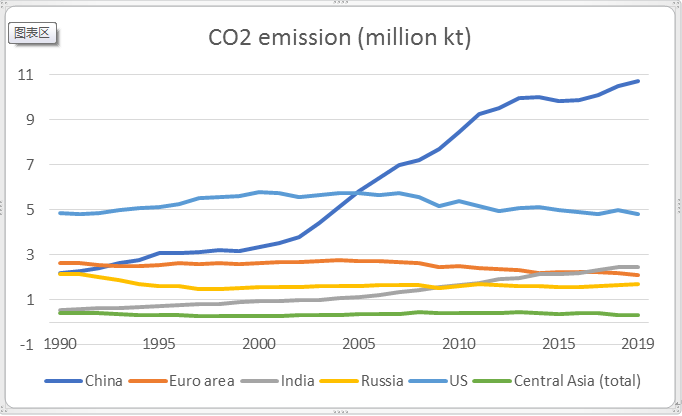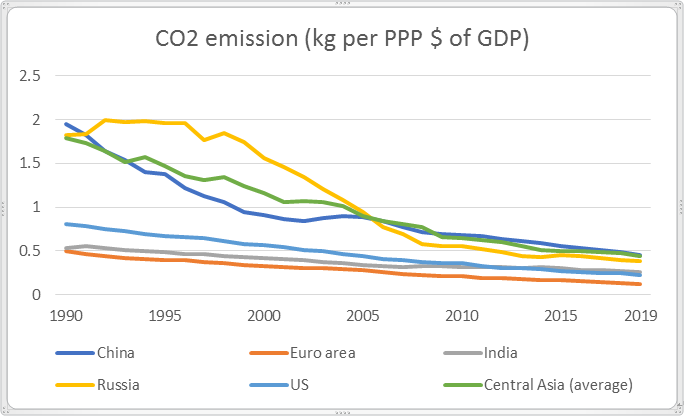
Air pollution increasing day by day with the arrival of winter in Bishkek, capital of Kyrgyzstan, December 26, 2020. /CFP
Air pollution increasing day by day with the arrival of winter in Bishkek, capital of Kyrgyzstan, December 26, 2020. /CFP
Editor's note: Djoomart Otorbaev is the former prime minister of the Kyrgyz Republic, a distinguished professor of the Belt and Road School of Beijing Normal University, and a member of the Nizami Ganjavi International Center. The article reflects the author's views, and not necessarily those of CGTN.
In January 2022, a virtual summit was held with participation of Chinese President Xi Jinping and the leaders of all five Central Asian countries, dedicated to the 30th anniversary of the establishment of diplomatic relations. Among other things, Chinese President said that his country will provide a $500 million grant to Central Asian countries for the period up to 2030 for sustainable development. How essential is the climate change problem for Central Asia? How important is it to support Central Asian nations in their grand quest for carbon neutrality?
Mountains and glaciers made the territory of Central Asia habitable. Glaciers on the mountain peaks of the Pamir and Tianshan provide water to the surrounding valleys, just when it is needed to irrigate the soil in spring and summer. Natural water arteries and artificial channels irrigate various oases on their way.
Where water is scarce, the land turns into deserts such as the Karakum desert in Turkmenistan, the Kyzylkum desert in Uzbekistan and Kazakhstan, the Taklamakan desert in China, and the Registan desert in Afghanistan. That is why Central Asia is emerging as one of the first regions on the planet that feels and will feel even more the consequences of climate change.
Due to global warming, mountainous glaciers are experiencing huge losses in area and mass. Researchers have shown that along the Tianshan Mountain range, which is the most extensive chain in Central Asia, over the past 50 years glaciers have lost 27 percent of their mass and 18 percent of their area.
An international environmental group has calculated that by the 2050s, about half of the current Tianshan's glaciers could cease to exist. If these estimates are correct, in less than a century, Central Asia could lose over two-thirds of its glaciers and therefore more than two-thirds of its water.
How could agriculture, a sector that employs more than half of the region's population, survive? Will it make sense to build giant hydroelectric power plants for which there is not sufficient water? The problem of climate change in Central Asia is not only a theoretical problem, but a real threat. Countries must immediately start fighting this global menace.
Figure 1 shows carbon dioxide emissions for the last 30 years in the leading countries and regions and their comparison with respective emissions in Central Asia.

Figure 1. /based on data from the World Bank
Figure 1. /based on data from the World Bank
The top five polluters of the planet include China, the U.S., India, Russia, and Japan. Kazakhstan, which is the main emitter of carbon dioxide in Central Asia, ranks 20th. Figure 1 shows that in the Eurozone and the U.S., they have not been rising for at least 15 years. These trends are explained by the growth of the population and economies in those countries. Emissions in India have recently exceeded those in the whole Eurozone.
The graph shows total carbon dioxide emissions in five countries of Central Asia combined. One can see that the absolute emission figures are modest. Nevertheless, it is important to compare the dynamics of carbon dioxide emissions normalized to GDP at purchasing power parity (PPP). Such a graph is shown in Figure 2.

Figure 2. /based on data from the World Bank
Figure 2. /based on data from the World Bank
Those charts show how carbon emissions have changed over the past 30 years. First, in all countries and regions, there is a drop in emissions per GDP (PPP), which is associated with a change in their economic structures. The trend is especially pronounced in China, Russia, and Central Asia (the dynamics of emissions averaged over all five countries in Central Asia are presented). Such a sharp dynamic is associated with changes that have taken place in the structure of their economies, including those related to the replacement of outdated technologies.
In Russia and Central Asia, the fall in emissions was associated with a sharp decline in economic activities as well, especially noticeable in the 1990s and the beginning of the 2000s. According to data from Emissions Database for Global Atmospheric Research, in the countries of Central Asia, carbon dioxide emissions from 1990 to 2020 decreased by 5, 12 and 46 percent in Uzbekistan, Kazakhstan and Kyrgyzstan, respectively.
In 2015, the historic Paris Agreement on climate change was signed, in which member countries agreed to reduce greenhouse gas emissions, take action to adapt to climate change, develop a low-carbon economy and promote the exchange of green technologies. Its main goal was to keep global warming within 1.5 degrees Celsius in the current century.
The U.S., EU, Kyrgyz Republic, and Tajikistan aim to achieve carbon neutrality by 2050, Russia, China, and Kazakhstan by 2060, and India by 2070. By the middle of the century, Uzbekistan hopes to get close to zero emissions; however carbon neutrality will be achieved only for the energy sector.
In today's world, it has become more obvious that to achieve results combating climate change, it is necessary to move from words to deeds. The Central Asian countries must stand at the forefront of this fight.
Countries have developed specific plans to combat climate change. But what human, technological, and financial resources are Central Asian nations preparing to achieve success in this fight? Their success will depend on the realism of their plans and perseverance in achieving them. But most of all, international efforts in this direction will be required. That is why China's proposals for cooperation in this area are important and timely.
(If you want to contribute and have specific expertise, please contact us at opinions@cgtn.com. Follow @thouse_opinions on Twitter to discover the latest commentaries in the CGTN Opinion Section.)

